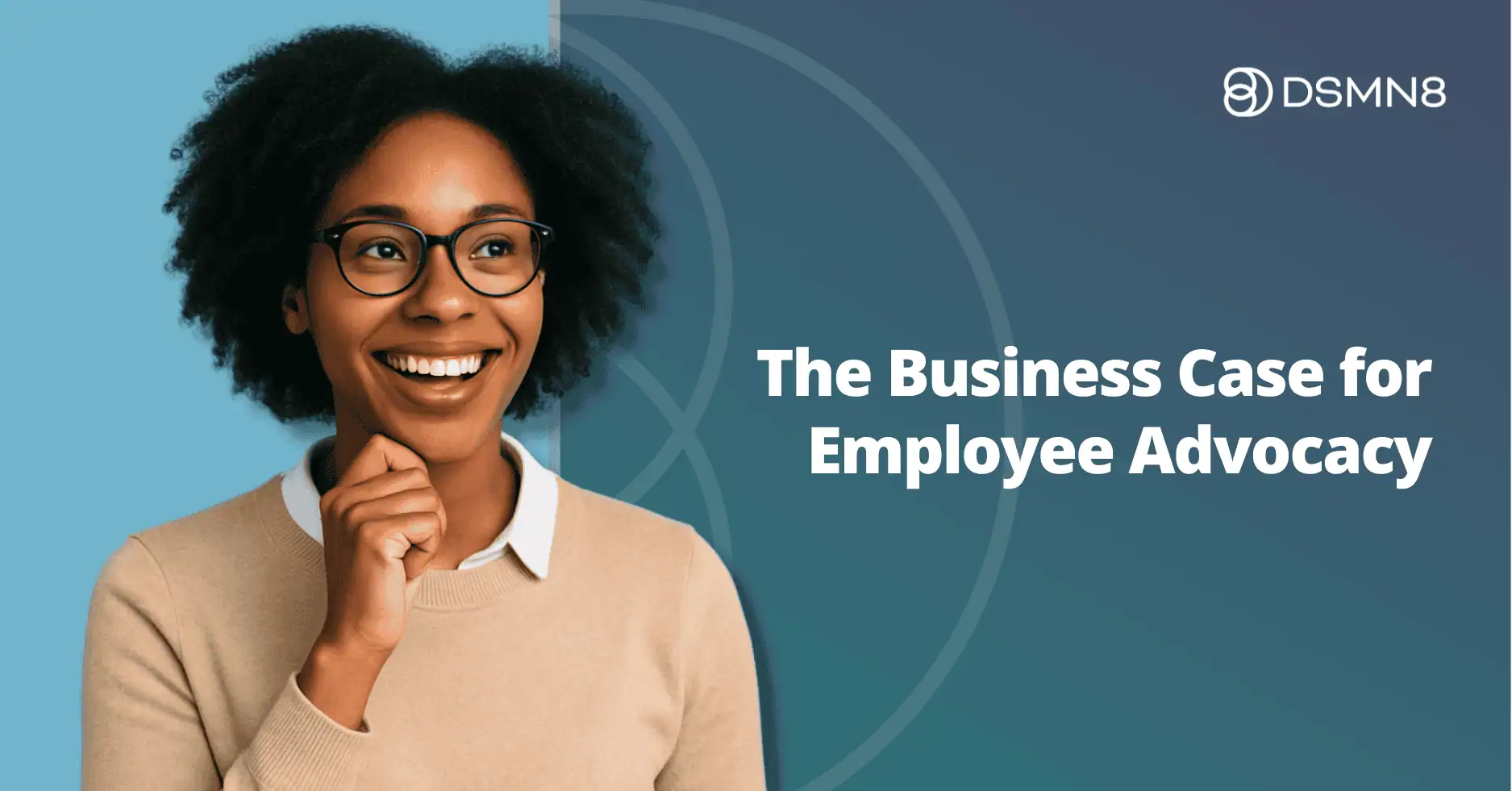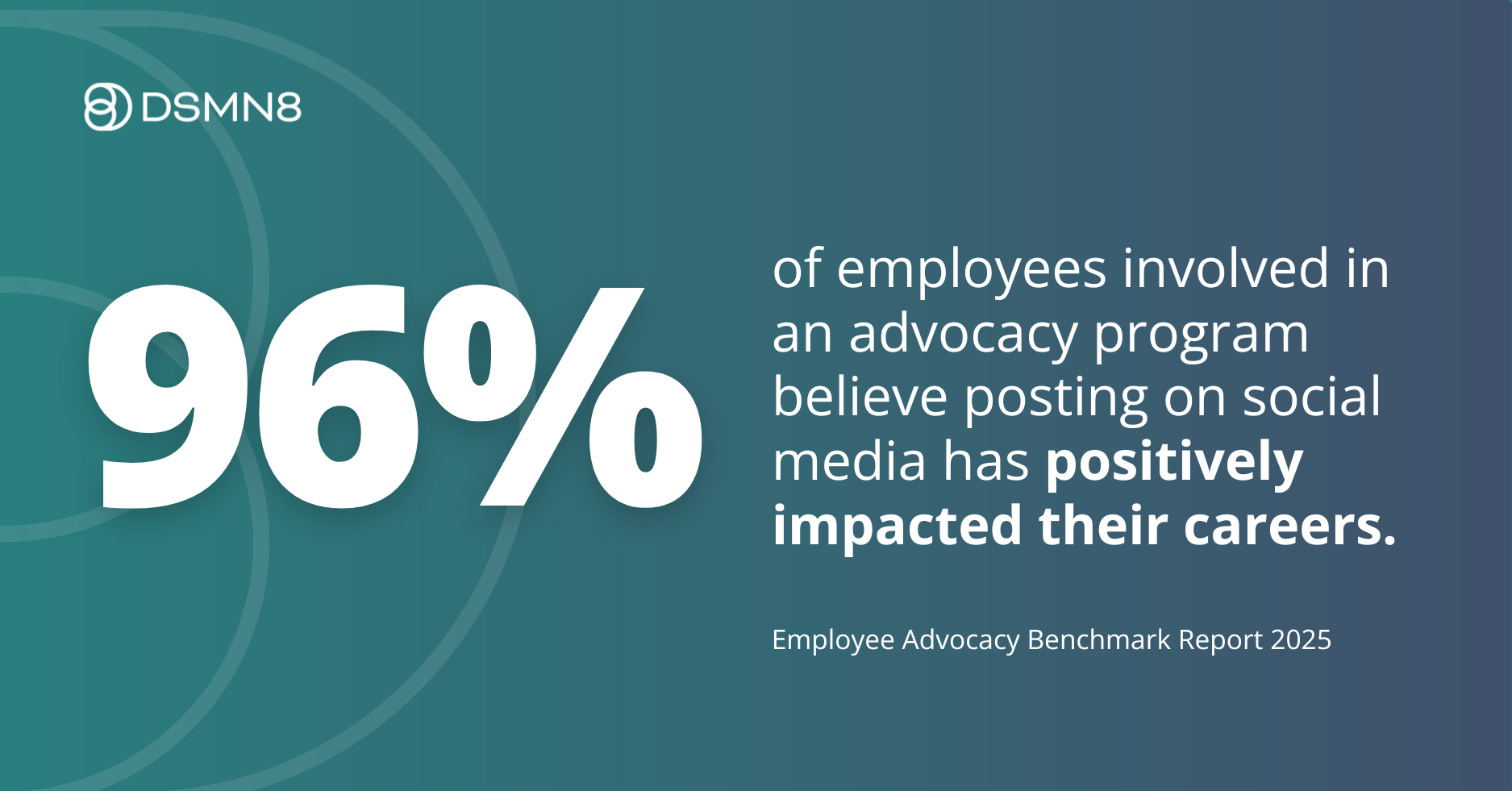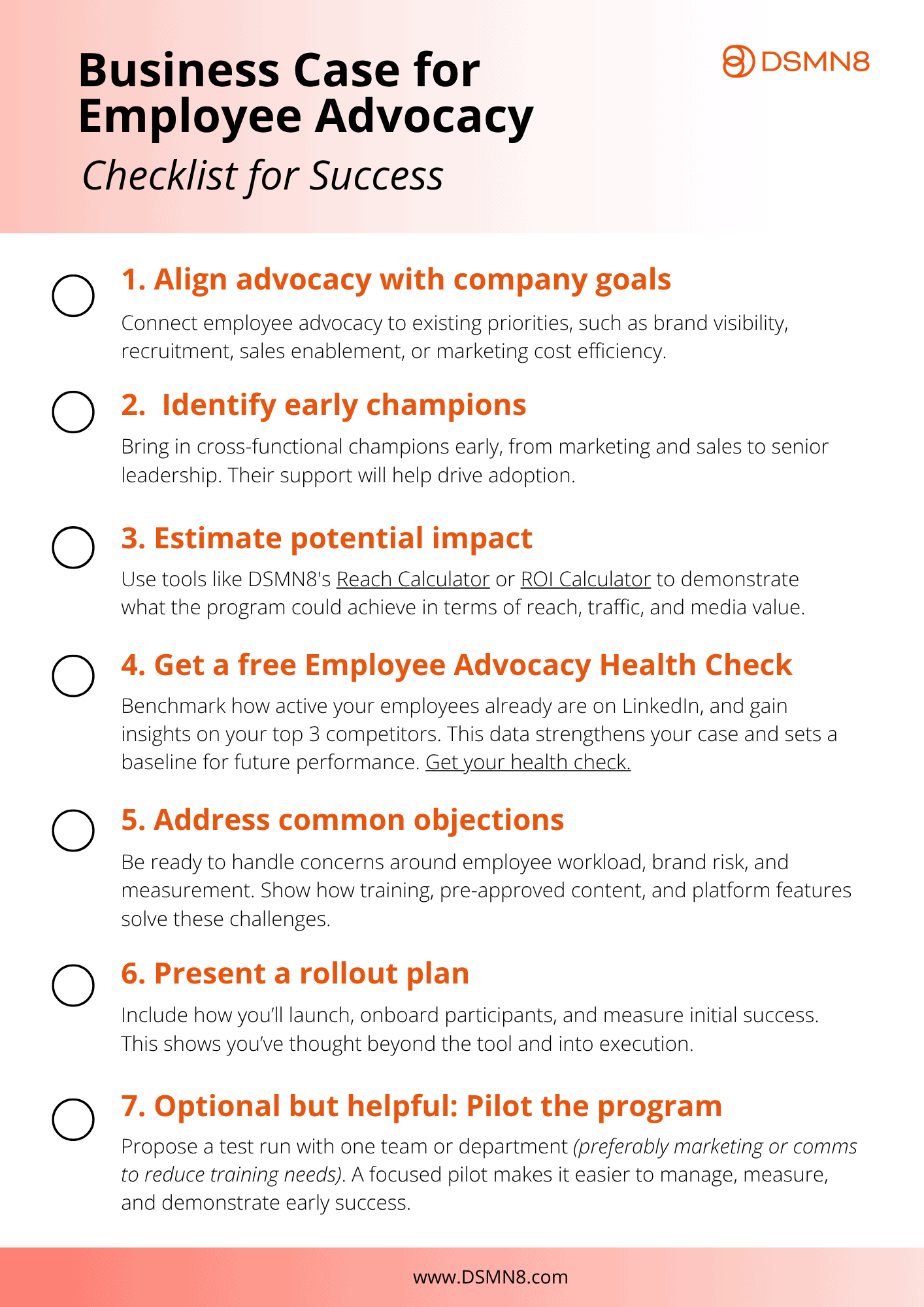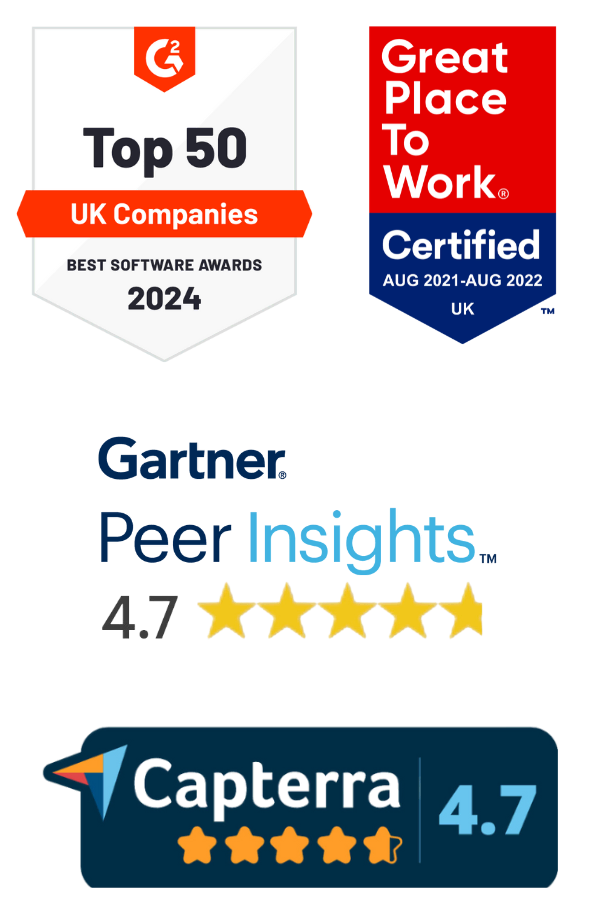
You know the benefits of employee advocacy. But now you’ve got to convince your leadership team.
Maybe they’re asking tough questions about ROI. Maybe they see it as just another marketing tool. Or maybe they simply don’t understand the potential.
This article is here to help you make a compelling business case for employee advocacy, backed by data and real-world outcomes across marketing, sales, HR, and beyond.
Why You Need a Business Case for an Employee Advocacy Program
Launching an employee advocacy program without internal buy-in is like trying to steer a ship with no wind.
Employee advocacy isn’t just a tool, it’s a company-wide initiative. It impacts everything from recruitment and sales to employee engagement and brand reputation.
That’s why building a strong business case is essential. You’re not just getting buy-in for a platform, you’re securing support from stakeholders across departments and setting the foundation for long-term success.
The Challenge: Declining Organic Reach and Trust in Brand Channels.
Let’s start with what we’re up against.
These changes reflect a shift in how people engage with companies online.
Advocacy isn’t just a workaround for low reach. It’s a smarter, more human way to connect in a world where people trust people more than brands.
The Payoff: Tangible Business Benefits
So, what do you get in return for investing in employee advocacy? A lot more than just likes and shares.
From boosting brand visibility to cutting paid media costs, the impact spans multiple departments. Here’s how advocacy drives real business results.
1. Amplified Content Distribution
Your marketing team is already producing valuable content. But without the right distribution, much of it goes unseen.
A LinkedIn study found that employee networks are, on average, 10 times bigger than a company’s own following. When you combine that with an algorithm that prioritizes people over pages, it’s clear why employee-shared content consistently outperforms brand posts.
If you want your content to actually be seen, start with the people behind it.
2. Maximize Social Selling
Your buyers are on LinkedIn, and your sales team should be too. But just showing up isn’t enough; they need to provide value.
78% of social sellers outsell peers who don’t use social media. Consistency is key, but here’s the thing: most salespeople simply don’t have time to create content from scratch.
With the right employee advocacy tool, content creation doesn’t have to be a time drain. Sales teams get instant access to a library of pre-approved, on-brand posts they can personalize and schedule. With DSMN8, they can even automate posting at their preferred cadence and optimal times, making it easier than ever to stay top-of-mind and build trust.
3. Crowdsource Authentic Content
Your marketing team can’t be everywhere at once. That’s where employee-generated content is a game changer, especially for recruitment and employer branding.
A culture of advocacy in your organization ensures that your team feels comfortable and supported in creating content, and an employee advocacy platform offers a space for it to be shared and tracked.
It’s authentic, scalable, and a win-win: your brand gets fresh content, while employees build their personal brands.
4. Employer Branding
In a competitive hiring market, a strong employer brand isn’t optional; it’s essential.
In 2024, 77% of HR professionals reported that hiring top talent was their greatest challenge.
According to Forbes, although referrals make up only 7% of applicants, they drive 45% of hires.
Employee advocacy provides candidates with an authentic glimpse into life at your company, one that staged photos or career pages can’t replicate. That kind of authenticity is what top candidates are looking for.

5. Employee Engagement & Empowerment
Advocacy isn’t just a broadcast tool; it’s a career development engine.
In our 2025 Benchmark Report, 96% of employee advocates said social media had a positive impact on their careers.
And it’s easy to see why. An advocacy program helps employees build confidence, grow their personal brands, and unlock new opportunities from networking, to speaking engagements, and even career progression.
Empowered employees become more engaged, more visible, and more invested in your company’s success.
As Andy Lambert (ContentCal Co-Founder and Adobe Senior Product Manager) puts it:
“Whether it’s financial, career-related, or opportunities like speaking at events or connecting with execs, people need to feel this contributes to their personal growth. When framed as part of personal development, employees are more likely to engage meaningfully.”
Watch Andy’s guest episode on the Employee Advocacy & Influence podcast for more on what he calls ‘Social 3.0’:
6. Performance Marketing
Let’s talk budget.
The average cost per click on LinkedIn in 2025 is $5.58. DSMN8 clients consistently see CPCs under $1, and in some cases, far lower. AWIN, for example, achieved an impressive £0.23 CPC through employee shares alone.
Factor in earned media value (EMV), and the cost savings become even clearer. With advocacy, your best-performing content doesn’t have to come with a price tag.
Employee Advocacy Objectives by Department
| Department | Goals | How Advocacy Helps | Metrics to Track |
|---|---|---|---|
| Marketing/Comms | Brand visibility, content reach, engagement. | Amplifies marketing content through employee networks. | Organic reach, traffic, CPC, EMV, content engagement. |
| Sales | Pipeline growth, relationship building. | Supports social selling, builds trust with prospects. | Social selling adoption, lead quality, conversion rate. |
| HR / People | Employer brand, talent attraction, retention. | Shows culture authentically, boosts employee voice. | Recruitment cost, referrals, employee satisfaction. |
| Leadership | Thought leadership, visibility, trust. | Builds personal brand, improves credibility with industry and talent. | Follower growth, post engagement, media mentions. |
| Customer Success | Retention, satisfaction, advocacy. | Improves trust, shares helpful insights publicly. | NPS score, CSAT trends, community engagement. |
| Internal Comms | Culture, engagement, alignment. | Makes employees more informed and engaged with company news. | Share rates, active users, eNPS. |
Making the Case Internally
Now you’re clear on the benefits, the next step is presenting a compelling case to your stakeholders.
To achieve this, you’ll need to align advocacy with your company’s strategic goals, address potential concerns, and clearly demonstrate how it’ll deliver a measurable return on investment.
Think beyond features: focus on outcomes that matter to leadership, whether that’s increased visibility, better talent acquisition, or reduced paid media spend.
Consider trialling advocacy with a pilot program to demonstrate impact before expanding. Nissan launched with 500 employees with DSMN8 before scaling to over 2,000 users, using early success to build momentum across the business.
Below, you’ll find a step-by-step checklist to help you frame your proposal, build confidence, and win the support you need to get started.
Employee Advocacy Business Case Checklist
Use this checklist to shape a compelling proposal and secure cross-functional buy-in across your organization:
✅ Align advocacy with company goals
Connect employee advocacy to existing priorities, such as brand visibility, recruitment, sales enablement, or marketing cost efficiency.
✅ Identify early champions
Bring in cross-functional champions early, from marketing and sales to senior leadership. Their support will help drive user adoption.
✅ Estimate potential impact
Use tools like our Reach Calculator or ROI Calculator to demonstrate what the program could achieve in terms of reach, traffic, and media value.
✅ Get a free Employee Advocacy Health Check
Benchmark how active your employees already are on LinkedIn, and gain insights on your top 3 competitors. This data strengthens your case and sets a baseline for future performance. Get a personalized health check.
✅ Address common objections
Be ready to handle concerns around employee workload, brand risk, and measurement. Show how training, pre-approved content, and platform features solve these challenges.
✅ Present a rollout plan
Include how you’ll launch, onboard participants, and measure initial success. This shows you’ve thought beyond the tool and into execution.
✅ Optional but helpful: Pilot the program on a small scale
Propose a test run with one team or department (preferably marketing or comms to reduce training needs). A focused pilot makes it easier to manage, measure, and demonstrate early success.
Final Thoughts & Additional Resources
You’re already investing in content, talent, paid campaigns, and brand building.
But without the right distribution and trust signals, much of that effort never reaches its full potential.
Employee advocacy brings it all together. It amplifies your message, builds credibility through real voices, and drives results without ballooning your budget.
And with the right technology, it’s easy to get started, scale up, and show the impact.
Want to talk strategy? Book a demo with our team to explore what’s possible.
Emily Neal
SEO and Content Specialist at DSMN8. Emily has 10 years experience blogging, and is a pro at Pinterest Marketing, reaching 1 million monthly views. She’s all about empowering employees to grow their personal brands and become influencers.





